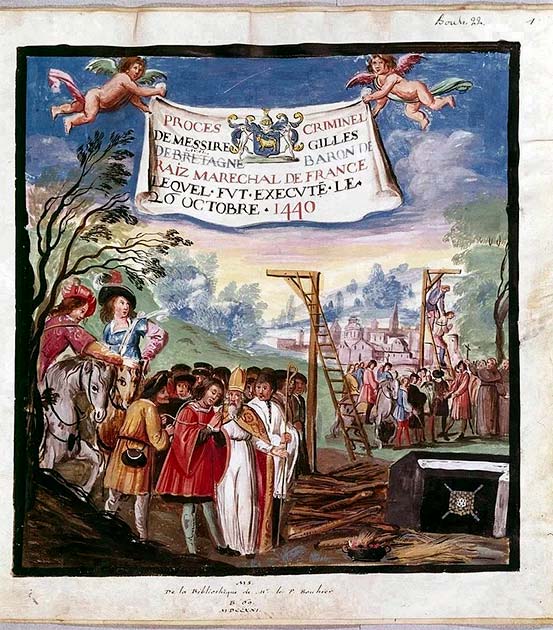The psychology of murder is a fascinating topic, and one we have only in recent decades sought to truly understand. Most murders are crimes of necessity, but understanding the inner drive to kill again and again, especially where the act of killing is the focus and the motive, remains largely mysterious.
Some murderers kill for sexual gratification, or otherwise to feel powerful. Some kill for revenge, and some kill following some inner delusion. But every killer is different, and as with the case of Baron Gilles de Rais, it seems that some kill simply because they can.
Who was Baron Gilles de Rais?
Baron Gilles de Rais was a Breton nobleman born in early 15th century France (most likely 1404 or 1405) to Guy II de Montmorency-Laval and Marie de Craon in the family castle at Champtocé-sur-Loire. His early life was touched by tragedy when he lost both his parents at an early age.
In 1415, the year the French king lost his country to England at Agincourt, his father was killed in a gruesome hunting incident (which de Rais may have seen). His mother died the same year, the cause unknown.
De Rais and his brother were placed in the care of their maternal grandfather, Jean de Craon. His grandfather spent the next few years trying to marry both boys off to wealthy heiresses, and in 1420 married the sixteen year old de Rais off to Catherine de Thouars of Brittany.
De Rais chose to be a soldier and served as a commander in the Royal Army from 1427 to 1435. He quickly made a name for himself for his bravery and fighting prowess on the battlefield.

He was so respected that when Joan of Arc appeared, promising the French victory against the overrunning Engish in 1429, de Rais was assigned to watch over her. The two went on to fight side by side in several major battles including the Siege of Orleans.
His military career peaked in 1429 when he was made marshal of France, the country’s highest military distinction. After the death of Joan of Arc however, he retired from public life and he began spending more and more time on his estate.
- The Blood Countess of Hungary: Was Elizabeth Báthory a Vampire?
- The Diary of Jack the Ripper: Inside the Mind of a Madman?
By 1434 or 1435 de Rais had basically retired entirely. He began spending vast sums on decorating his castle and commissioning music and works of literature. He was eventually forced to sell family lands to keep up with his spending habit, which led to a fight with the rest of his family.
Much of this money was spent building the beautiful Chapel of the Holy innocents and on producing Le Mystère du Siège d’Orléans, a play that featured 20,000 lines of verse and required 140 speaking parts and over 500 extras.
So Baron de Rais was a war hero and philanthropist whose biggest crime was fiscal irresponsibility right? Wrong. De Rais was a monster.
The Children who Disappeared
Around the same time de Rais was building his chapel, rumors began to spread that children were going missing in the areas surrounding de Rais’s estate and his various other properties. It seemed that whenever de Rais was in town, children went missing.
At first, the disappearances didn’t seem so strange. It was normal for young boys to leave their parents to work for nobles as servants or pages. After they had been taken on board by these nobles it was usual for the boys to lose contact with their parents. As such, the parents of most of de Rais’s victims likely had no idea what had happened. They simply believed their sons had gotten jobs.
Those who did suspect what was going on kept quiet. De Rais tended to target children from impoverished families whose parents couldn’t afford to feed them anyway or who would never dare accuse a mighty marshal of such heinous crimes.
Rumors continued to swirl around de Rais for almost a decade but no charges were ever brought against him. People were simply too scared to accuse him publicly.
How Was He Caught?
If de Rais was so untouchable, how was he caught? As is so common, de Rais’s eventual downfall at first had nothing to do with his murderous predilections.
On 15 May 1440, de Rais kidnapped a local cleric during a dispute at the Church of Saint-Etienne-de-Mer-Merte. This reckless act prompted an investigation by the Bishop of Nantes, during which de Rais’s crimes were brought to light.
- Amelia Dyer: the Most Prolific Serial Killer You’ve Never Heard Of
- The Teenage Fiend: Jesse Pomeroy, America’s Youngest Serial Killer and Rapist
Under the threat of torture de Rais admitted to the kidnapping, rape, and torture of well over 100 children, mostly young boys. His confession was backed up by those of his bodyguard, Etienne Corrillaut, and his cousin, Gilles de Sille, as well as several other servants.
The grizzly details are too grotesque to list in detail here. De Rais would send his servants to find and then lure children aged from 6 to 18 to his castle. He would then ply them with fine food, drink, and clothes.
Once they were suitably intoxicated, the children were led to an upper room where de Rais would strip and bind them. He would then torture, rape and either kill them himself or have one of his servants do it while he watched.
In his own confession, and in those of his servants, it was noted how much pleasure de Rais took in acts of sadism. He often mutilated the bodies of the children after they were dead, especially if he had found them especially “attractive”.
Most estimates put de Rais’ victim count at 100-200 children over a ten year period, but some put it closer to 600. We’ll never know the exact number. At his trial, de Rais was found guilty of multiple crimes including murder, rape, sodomy, and blasphemy. He was sentenced to death by being burned and hung at the same time.

He was executed in Nantes on October 26, 1440. Before his execution, he was contrite and composed, which, terrifyingly, earned him posthumous fame as a “model of Christian penitence”. A three-day feast was even observed after his death in his name.
A Murky Tale
Some modern revisionists have revisited the tale of de Rais and questioned whether he was guilty or not. His confession was extracted through the threat of torture and some historians have claimed he was the victim of some ecclesiastical plot to kill him and destroy his reputation.
Most historians, however, believe he was truly guilty. The confessions of him and his accomplices are grotesquely detailed and other eyewitness accounts surfaced during his trial from people who claimed to have seen his servants dumping children’s bodies.
There’s also the troubling fact that hundreds of children in his vicinity went missing. Even by the standards of the time, this was a lot. There seems to be little doubt that de Rais was truly a monster and murderer of children. A strong candidate not just for history’s first serial killer, but perhaps, its worst too.
Top Image: Baron Gilles de Rais, once marshal of France, was executed for the murder of hundreds of children over ten years. Source: Fxquadro / Adobe Stock.